Furlough, returning to work and adapting to new working routines – how are employees feeling about recent changes?
Key findings:
- 58% of employees feel that their emotional wellbeing has been negatively impacted in the past month, highlighting the effects of changes in regulation to mental wellbeing
- Despite being a job retention scheme, furlough caused 61% of employees in the scheme concerns over job future security
- Over 1 in 10 who remained working felt resentful for furloughed colleagues’ time off
- More than half feel that their employer handled the process of furloughing employees well
- A huge 65% of employees believe senior leadership should take a pay cut before considering redundancies for staff
- Less than half of employees (47%) feel safe in regards to returning to work
- Over 1 in 5 employees have had no guidance on how to return to work, with just 15% of businesses setting a fixed date for returning to work
Intro
Employees and companies around the country are currently within different stages of the ‘new working world’ of 2020.
Many employees are still within the furlough scheme, while others are gradually returning to work or working part-time. On the other hand, some companies are gearing up for their return to the workplace, while many others are planning to stick with their working from home routines for some time longer.
That’s a lot of things for employees to get their head around.
We wanted to find out how these different circumstances are affecting employees. We surveyed 6,273 UK employees to find out how they are feeling and if they’re receiving the support they need.
Overall, emotional wellbeing has been negatively impacted in the past month
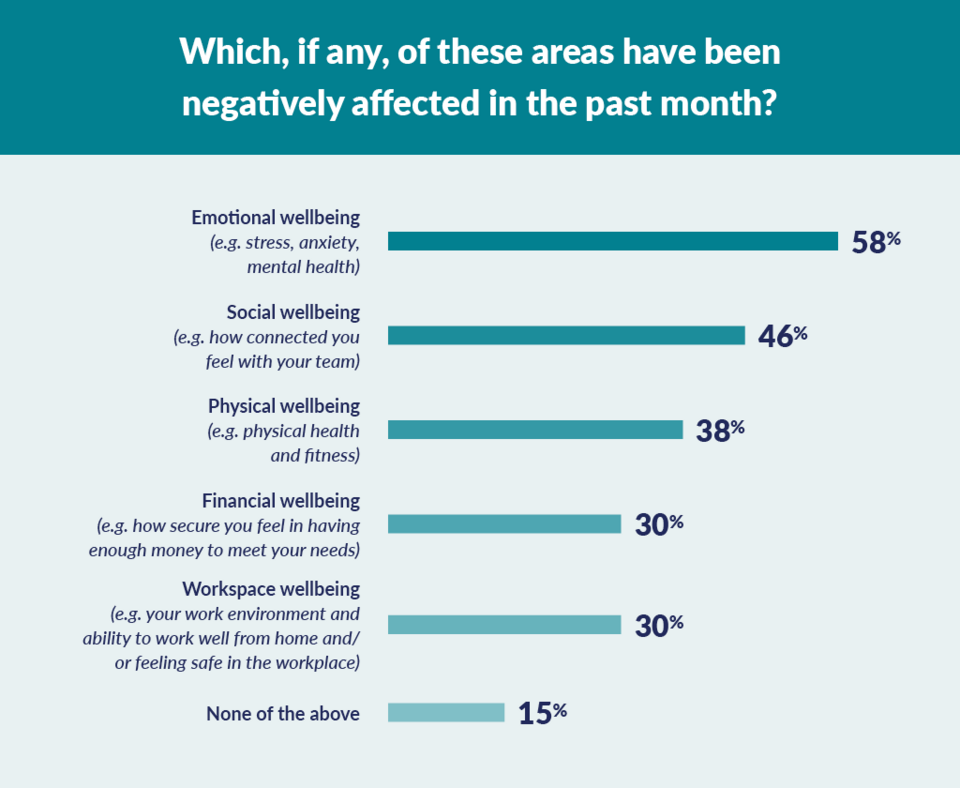
58% of employees feel that their emotional wellbeing has been negatively impacted in the past month, highlighting the effect that changes in regulation have caused on mental wellbeing.
This is followed by social wellbeing (46%) and physical wellbeing (38%), with financial wellbeing being least affected (30%) in the past month.
Overall, only 15% felt that they hadn’t experienced any negative impacts to their wellbeing in the past month.
Despite being a job retention scheme, furlough led to 61% of employees with concerns over job future security

Download now: Our new wellbeing strategy guide for remote and non-remote workforces
According to Statista, as of June 28, 2020, approximately 9.3 million jobs, from 1.1 million different employers were furloughed in the United Kingdom as part of the Government’s job retention scheme.
As the economic climate starts to stabilise, many furloughed employees are now returning to work. But how did this situation make them feel? And how did this affect the employees who remained working through this turbulence?
Of the 6,273 people we surveyed, 28% had been placed on furlough during 2020.
Positively, almost half (45%) of those furloughed enjoyed the time off and break from working – showing that during the stressful events of this year, time to focus on personal lives and families was appreciated by employees.
But overall, the most popular feeling from those placed within the furlough scheme is concern about their future job security. Despite furlough being a job retention scheme, a huge 61% of furloughed employees feel these concerns, followed by 42% who are concerned about the future of their employer due to participation within the scheme.
Furlough also brought feelings of guilt, with 29% feeling guilty about not working, while over 1 in 5 (21%) felt guilty for extra work that colleagues had to take on in their absence.
Over 1 in 10 who remained working felt resentful for furloughed colleagues’ time off

For those who weren’t placed on the scheme themselves, many felt the impacts of their colleagues being furloughed to their working lives.
Almost 1 in 5 (19%) employees who weren’t furloughed by their employers (but their company did utilise the scheme), felt more secure in their job by not being chosen for the scheme. Nevertheless, 18% do feel concerned about the future of their employer through the use of the furlough scheme.
With colleagues out of work, remaining employees have had to work harder (19%) and experience more stress due to taking on extra responsibilities (18%). 16% have also experienced impacts to their emotional wellbeing.
This resulted in over 1 in 10 (11%) feeling resentful for their furloughed colleagues' time off while they remained working.
This data reveals a cause for concern for employers. Although the scheme is intended to protect jobs, employers need to be aware of the impacts on employees who are having to take on extra work in their colleagues’ absence. This has the potential to lead to increased incidents of burnout, which can have lasting effects on employees and on a large scale, take time for companies to recover from.
Cases of resentment felt by non-furloughed employees also show that HR teams may have to work harder to keep those who have continued to work throughout the pandemic engaged and happy throughout the rest of the year.
More than half feel that their employer handled the process of furloughing employees well
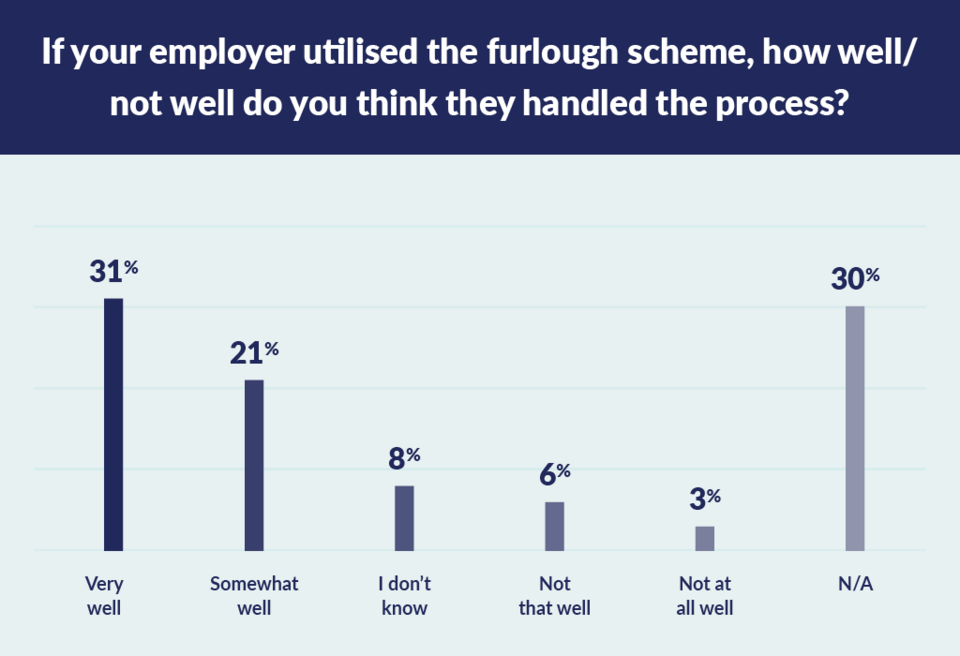
Furloughing staff is an experience that many employers and HR teams have not faced before. Getting the balance right between cost-saving and having an efficient workforce, all while maintaining strong employee wellbeing, is hard to get right.
Despite this, positively, more than half (52%) of employees feel that their employer handled the process of furloughing employees well, with just 9% feeling the opposite.
As job insecurities are high, employees expect senior leadership pay cuts before staff redundancies
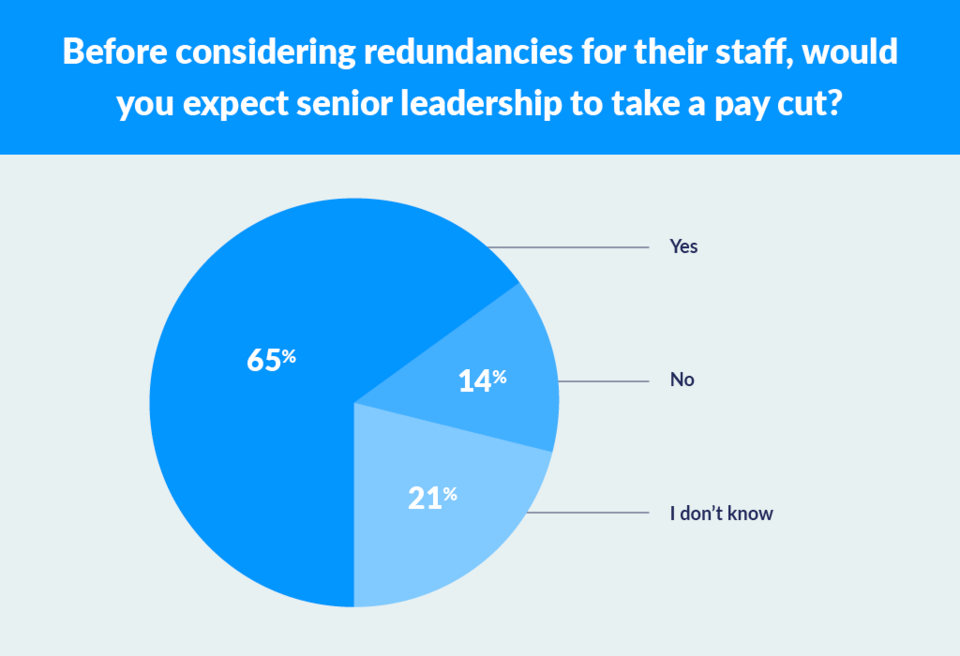
While a huge 61% of employees found that being placed on the furlough job retention scheme actually left them feeling concerned about their future job security, employees expect senior leadership to take personal action before considering redundancies for staff.
65% stated that they believe senior leadership should take a pay cut first, with just 14% responding that they wouldn’t expect this from their company’s leaders.
As many begin to slowly return to work, how safe do employees feel?
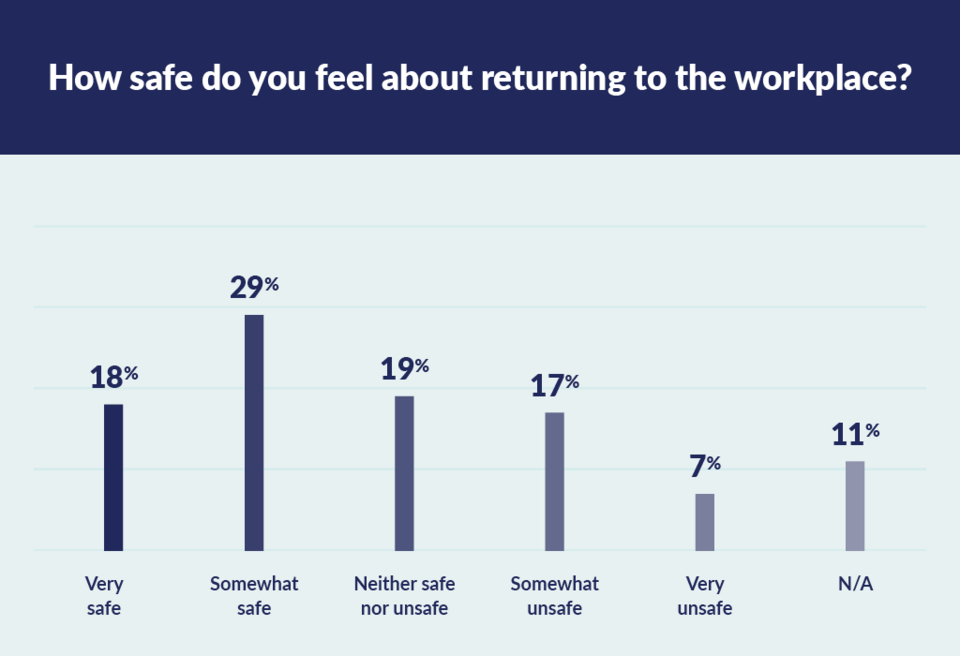
The next stage in the pandemic is beginning, with restrictions being lifted and the government encouraging companies to slowly return to work. We wanted to find out how prepared employers are and how supported employees feel in this transition.
For those employees who’ve been out of the workplace since the start of the pandemic, it's likely that they may be apprehensive about their return.
Shockingly, less than half of employees (47%) feel safe in regards to returning to work (equal between office-based and non-office-based workers), with almost a quarter (24%) responding that they feel ‘unsafe’ about this. To provide a comparison, 37% feel safe returning to a retail or hospitality venue.
Looking into what companies have done to return to work, it comes as no surprise as to why employees may be apprehensive.
Over 1 in 5 employees have had no guidance on how to return to work
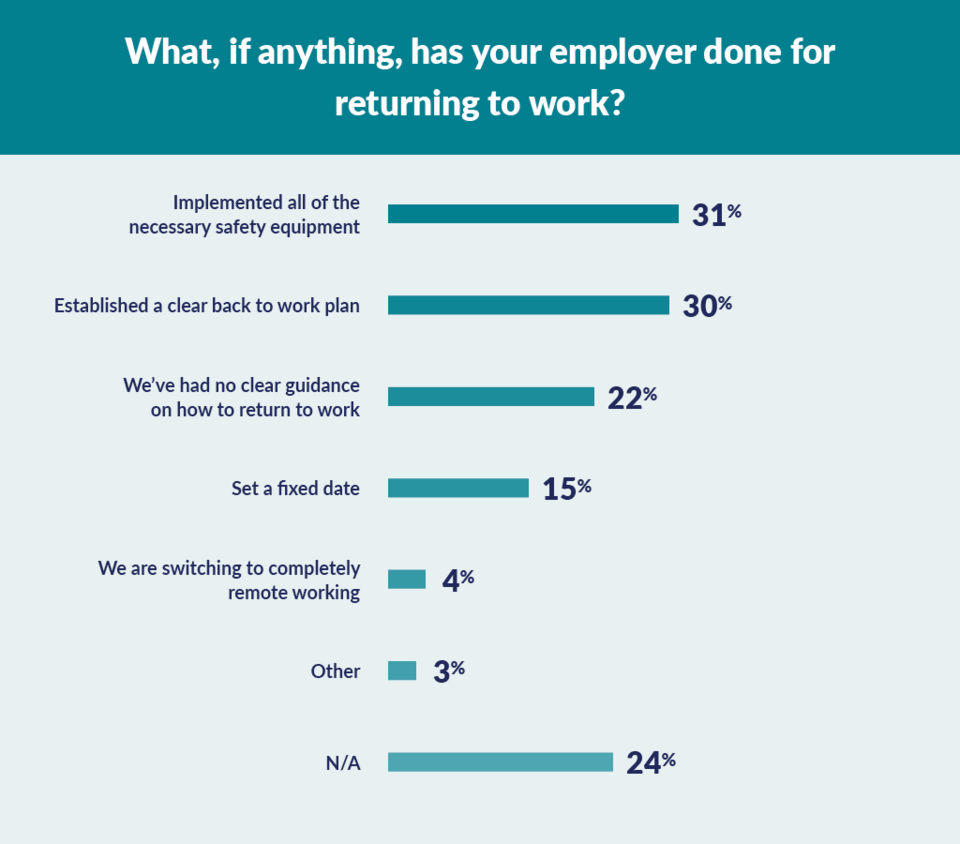
Despite the government's announcement that companies who’ve been working from home should slowly start to return to work, just 15% of businesses have set a fixed date for returning to work. A further 22% of employees have received no clear guidance on how to return to work.
Does this show that companies are happy with their new working routines and are in no rush to return to normality, or are they simply underprepared?
Surprisingly, less than a third (31%) of employees reported that their employer had implemented all of the necessary safety equipment to return to work, with just 30% of companies establishing a clear back to work plan.
Further, despite companies such as Twitter announcing that all employees can work from home ‘forever’, very few UK companies appear to be following suit so far. Just 4% of employees state that their company is switching to completely working from home. This begs the question of when companies are planning to communicate return to work plans for employees.
Ensuring health and safety, staying safe while commuting and finding balance are the key challenges of returning to work
These fears of safety are further shown by the key challenges that employees feel will come with returning to work. A huge 64% think ensuring health and safety at work is one of the main challenges, followed by 39% who are concerned about staying safe while travelling.
Showing how many employees' mindsets have changed in regards to the adaption of working from home, one of the main challenges that employees cited about returning to work is finding the right balance between the amount of remote days and workplace days. Over a third (36%) of employees feel that this will be a challenge in the future – highlighting further how employees aren’t ready to return to their old ways of working.
For those on the furlough scheme, 1 in 5 (20%) think it will be a challenge to readjust to working again after furlough.
Working from home still brings challenges of work/life balance and staying productive
Despite the many changes, many employees are still working remotely, as they have since the start of the pandemic.
When asked what they find the key challenges of remote working to be, half stated that their biggest challenge is striking a work/life balance. While working at home, it can be easy for the line to blur between working time and personal time and can overall lead to serious impacts on emotional wellbeing and potential burnout. With 40% struggling to maintain good emotional wellbeing it is clear that these effects are being felt by those working remotely.
43% also struggle staying productive/engaged and those who find it a challenge keeping up to date with communications across the business (39%).
What’s next?
As part of our New Working World series, we’ll be producing a series of surveys to track employee sentiment towards wellbeing as we move into a work post-coronavirus. This is being run alongside a survey of UK employers to see the business perspective on the wellbeing impact of 2020’s events.
Come back next month to find out how employees have adapted to these changes.



Share